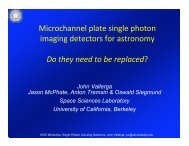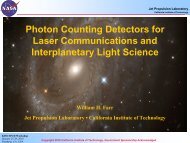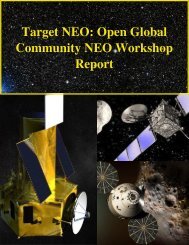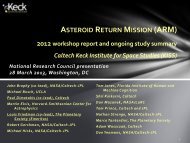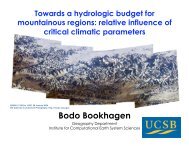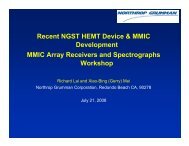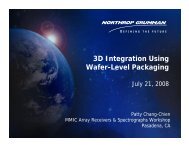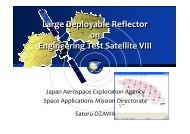1.84 MB pdf - Keck Institute for Space Studies
1.84 MB pdf - Keck Institute for Space Studies
1.84 MB pdf - Keck Institute for Space Studies
Create successful ePaper yourself
Turn your PDF publications into a flip-book with our unique Google optimized e-Paper software.
Some Thoughts on<br />
Simulations in Terramechanics<br />
J.Y. Wong<br />
Professor Emeritus and Distinguished Research Professor<br />
Carleton University<br />
and<br />
Vehicle Systems Development Corporation<br />
Ottawa, Canada<br />
Copyright© 2011 J.Y. Wong. All rights reserved.<br />
The in<strong>for</strong>mation contained herein is solely <strong>for</strong> discussions at the Closing Workshop on “xTerramechanics -<br />
Integrated Simulation of Planetary Surface Missions”, at the <strong>Keck</strong> <strong>Institute</strong> <strong>for</strong> <strong>Space</strong> <strong>Studies</strong>,<br />
Cali<strong>for</strong>nia <strong>Institute</strong> of Technology, U.S.A., August 1-3, 2011. It is not <strong>for</strong> public release.
Contents<br />
• Introduction<br />
• Requirements <strong>for</strong> simulation models in<br />
Terramechanics<br />
• Applications of simulation model NWVPM to<br />
evaluating rover wheel mobility<br />
• Predictions of rover wheel per<strong>for</strong>mance on<br />
extraterrestrial bodies based on test data<br />
obtained on earth<br />
• Challenges and opportunities
Terramechanics<br />
• Terramechanics*, in a broad sense,<br />
is the study of the overall<br />
per<strong>for</strong>mance of terrestrial and<br />
extraterrestrial vehicles/machines<br />
in relation to its operating<br />
environment – the terrain.<br />
___________________________<br />
* “xTerramechanics” is a branch of Terramechanics as applied to<br />
extraterrestrial missions.
Terramechanics<br />
• The aim of Terramechanics is to<br />
provide guiding principles <strong>for</strong> the<br />
rational design, evaluation, selection<br />
and operation of terrestrial and<br />
extraterrestrial vehicles/machines.<br />
• In the further development of this<br />
branch of applied mechanics and<br />
simulation models in Terramechanics,<br />
one should not lose sight of this<br />
fundamental objective.
Simulation Models in<br />
Terramechanics<br />
• Simulations in general are intended to<br />
replicate the behavior of terrestrial or<br />
extraterrestrial vehicles/machines in the<br />
nature environment. This would provide a<br />
better understanding of the physical nature of<br />
the issues involved, leading to improvements<br />
in the design of future generations of vehicles<br />
/machines.<br />
• The input terrain data to simulation models<br />
should be collected, wherever practicable, in<br />
its natural state under undisturbed conditions,<br />
to ensure that the predictions made by the<br />
models are relevant to the field conditions of<br />
interest.
Simulation Models in<br />
Terramechanics<br />
• A well-developed simulation model would be<br />
useful in optimizing the design parameters of<br />
the type of vehicle/machine, <strong>for</strong> which the<br />
model is intended.<br />
• It may or may not lead to the creation of<br />
radically new (or revolutionary) design<br />
concepts <strong>for</strong> terrestrial or extraterrestrial<br />
vehicles/machines, however comprehensive<br />
or detailed the simulation model is.
Simulation Models in<br />
Terramechanics<br />
• Simulation models have to be developed<br />
and implemented in such a manner that<br />
will be conducive to practical solutions<br />
and will appeal to engineering<br />
practitioners.<br />
• The success of any simulation model in<br />
Terramechanics is judged by its impact<br />
on the design (or operation) of terrestrial<br />
or extraterrestrial vehicles/machines<br />
with enhanced per<strong>for</strong>mance.
Applications of Simulation<br />
Model NWVPM to<br />
Evaluating Rover Wheel Mobility
Computer-Aided Method NWVPM<br />
• It was originally developed <strong>for</strong><br />
evaluating the effects of design on<br />
the steady-state per<strong>for</strong>mance of<br />
terrestrial wheeled vehicles.<br />
• Recent studies have shown that it<br />
can be extended to the evaluation<br />
of the mobility and design of<br />
extraterrestrial rover wheels.
NWVPM is based on the analysis of and<br />
experimental data on the normal and shear<br />
stress distributions on the wheel-terrain<br />
interface.
Measured normal and shear stress distributions on the rim of a rigid wheel on<br />
compacted sand. (Onafeko & Reece, Journal of Terramechanics, Vol. 4(1), 1967.)
NWVPM<br />
• Major vehicle design features<br />
considered:<br />
– Vehicle weight and axle load distribution<br />
– Axle suspension stiffness<br />
– Type of the axle (driven or non-driven)<br />
– Tread of the axle (distance between the centers of<br />
left- and right-hand side wheels)<br />
– Wheel loads, dimensions and other parameters<br />
– “Multi-pass” effects of wheels in a multi-axle<br />
vehicle<br />
– Inter-axle load transfer
Multi-pass effects (Wong, et al., 1984)
NWVPM<br />
• Terrain parameters input to NWVPM are<br />
obtained using the Bevameter.<br />
• They include parameters <strong>for</strong> characterizing the<br />
pressure-sinkage relation, shear strength, and<br />
response to repetitive normal and shear<br />
loading of the terrain.<br />
• Terrain data are processed on-board of a<br />
mobile plat<strong>for</strong>m using a special software.<br />
• Together with a reduced-order simulation<br />
model (such as NWVPM), it is feasible to<br />
predict, close to real-time, rover mobility during<br />
driving operations on-board of a rover.
A vehicle-mounted Bevameter <strong>for</strong> measuring terrain properties.
A computerized data processing system <strong>for</strong><br />
a vehicle-mounted Bevameter.
Dr. Bekker examining the computerized data processing system<br />
<strong>for</strong> a vehicle-mounted Bevameter.
Control centre <strong>for</strong> operating NWVPM as displayed on the computer monitor.
NWVPM<br />
• Capabilities<br />
– Prediction of the tractive per<strong>for</strong>mance of<br />
wheeled vehicles/rovers, including sinkage,<br />
motion resistance, thrust, drawbar pull,<br />
tractive efficiency, etc. as functions of wheel<br />
slip.<br />
– Selection of a suitable wheeled vehicle/rover<br />
configuration and/or its wheels in a given<br />
operating environment.
Applications of NWVPM to Evaluating<br />
Lunar Rover Wheel Mobility<br />
- In collaboration with NASA Glenn Research<br />
Center (GRC), the potential application of<br />
NWVPM to the evaluation of the mobility of<br />
extraterrestrial rovers/rover wheels was<br />
evaluated.<br />
- The correlation between the per<strong>for</strong>mances of<br />
wheel candidates <strong>for</strong> the Lunar Roving Vehicle<br />
predicted by NWVPM and test data obtained by<br />
U.S. Army Waterways Experiment Station was<br />
examined. The details are published in a paper in<br />
the Journal of Automobile Engineering,<br />
Proceedings of the Institution of Mechanical<br />
Engineers, Part D, Vol. 222 (D11), 2008.
Journal of Automobile Engineering<br />
Proceedings of the Institution of Mechanical Engineers, Part D<br />
Vol. 222, No. D11, November 2008, pp. 1939 -1954.
-Wire-mesh wheels <strong>for</strong> the<br />
Lunar Roving Vehicle <strong>for</strong><br />
NASA’s Apollo missions,<br />
developed by the Boeing-<br />
General Motors team, are<br />
woven with steel wire and<br />
girded with titanium chevrons.<br />
They look like skeletons of<br />
pneumatic tires that support<br />
earthbound vehicles.<br />
-Weighing only 12 lbs, they<br />
are compatible with the<br />
vacuum and temperature<br />
extremes on the Lunar<br />
surface. (Source: NASA)
Comparison of the predicted drawbar pull to normal load ratio at 20% slip<br />
(P 20 / W) by NWVPM with the measured <strong>for</strong> the Boeing-GM IV and VI wheels<br />
on dry sand S1 (Wong and Asnani, 2008)<br />
Wheel<br />
type<br />
Boeing<br />
-GM IV<br />
Normal<br />
load<br />
(N)<br />
Contact<br />
(Ground)<br />
pressure (kPa)<br />
Measured*<br />
P 20<br />
/ W (%)<br />
Predicted**<br />
P 20<br />
/ W (%)<br />
Predicted /<br />
Measured (%)<br />
311 13.31 28 29.8 106.4<br />
Boeing<br />
-GM VI<br />
311 4.04 38.4 41.5† 108.1<br />
Boeing<br />
-GM VI<br />
311 4.42 38.4 40.9† 106.5<br />
* Source: WES Technical Report M-70-2, by Freitag, Green, and Melzer, 1970.<br />
** Based on average Bekker soil values and estimated K = 0.5 cm.<br />
†Taking into account the estimated coefficient of motion resistance due to<br />
wheel flexing of 4.3%.
Hoop-spring wheel developed by Bendix <strong>for</strong> the Lunar Roving Vehicle.<br />
(Source: NASA)
Comparison of the predicted drawbar pull to normal load ratio at<br />
20% slip (P 20<br />
/ W) by NWVPM with the measured <strong>for</strong> the Bendix<br />
lunar wheel on dry sand S 1<br />
(Wong and Asnani, 2008)<br />
Normal<br />
Load,<br />
N<br />
Contact<br />
(Ground)<br />
Pressure,<br />
kPa<br />
Measured*<br />
P 20<br />
/ W, %<br />
Predicted**<br />
P 20<br />
/ W, %<br />
Predicted /<br />
Measured,<br />
%<br />
67 2.76 42.4 37.2 87.7<br />
133 2.58 45.8 45.2 98.7<br />
311 3.93 46.3 47.3 102.2<br />
* Source: WES Technical Report M-70-2, by Freitag, Green, and Melzer, 1970.<br />
** Based on average Bekker soil values and estimated K = 0.5 cm.
Applications of NWVPM to Evaluating<br />
the Mobility of Extraterrestrial Rovers<br />
- Results of the study show that there is a<br />
reasonably close agreement between the<br />
predictions by NWVPM and test data.<br />
- This indicates that NWVPM can be used as an<br />
engineering tool <strong>for</strong> evaluating or comparing the<br />
mobility of extraterrestrial rover wheels.<br />
- The Surface Mobility Technology Team of<br />
NASA GRC has used NWVPM in the evaluation<br />
of extraterrestrial rovers and rover wheels <strong>for</strong><br />
future missions.
Prediction of Rover Per<strong>for</strong>mance on<br />
Extraterrestrial Bodies Based on Test<br />
Data Obtained on Earth<br />
• Test data obtained on earth, with loads<br />
applied to the wheels corresponding to those<br />
on extraterrestrial bodies, while soil<br />
simulants are subject to earth gravity, are not<br />
necessarily representative of the<br />
per<strong>for</strong>mance of the wheels on extraterrestrial<br />
bodies (such as, wheel sinkage and motion<br />
resistance).<br />
• The development of an appropriate<br />
methodology <strong>for</strong> predicting the per<strong>for</strong>mance<br />
of rovers on extraterrestrial bodies based on<br />
test data obtained on earth is needed.
A method <strong>for</strong> predicting the effects of<br />
gravity on rover wheel per<strong>for</strong>mance on<br />
extraterrestrial bodies, based on test<br />
results obtained on earth, is being<br />
developed. Results obtained so far<br />
indicate that the correlations between the<br />
predictions obtained using the method<br />
and available experimental data are<br />
reasonably close. Details of the method<br />
and its experimental substantiation will<br />
be published in the not too distant future.
Challenges and Opportunities<br />
• In parallel with <strong>for</strong>mulating new models<br />
<strong>for</strong> simulating terrain behavior, the<br />
procedures/techniques <strong>for</strong> acquiring<br />
the required input terrain parameters to<br />
the models should be developed.<br />
Otherwise the potential of their<br />
predictive capability could not be<br />
realized.
Challenges and Opportunities<br />
• To be useful <strong>for</strong> guiding the development<br />
of future generations of vehicles/<br />
machines, in <strong>for</strong>mulating new simulation<br />
models <strong>for</strong> vehicle/machine-terrain<br />
interaction, the design features of the<br />
vehicles/machines should be fully taken<br />
into consideration.<br />
• This is because the design features of<br />
the vehicle/machine have a significant<br />
impact on its interaction with the terrain.
Challenges and Opportunities<br />
In view of the complexity in modeling<br />
vehicle/machine-terrain interaction and<br />
the variability of terrain conditions in the<br />
field, it is suggested that <strong>for</strong> the<br />
<strong>for</strong>eseeable future, the role of a<br />
simulation model is to provide a<br />
practical and reliable plat<strong>for</strong>m <strong>for</strong><br />
evaluating the design or per<strong>for</strong>mance of<br />
vehicles/machines on a relative basis.
The End




